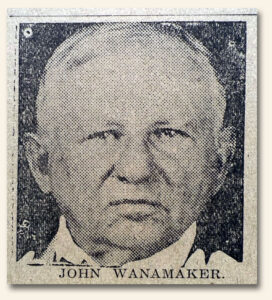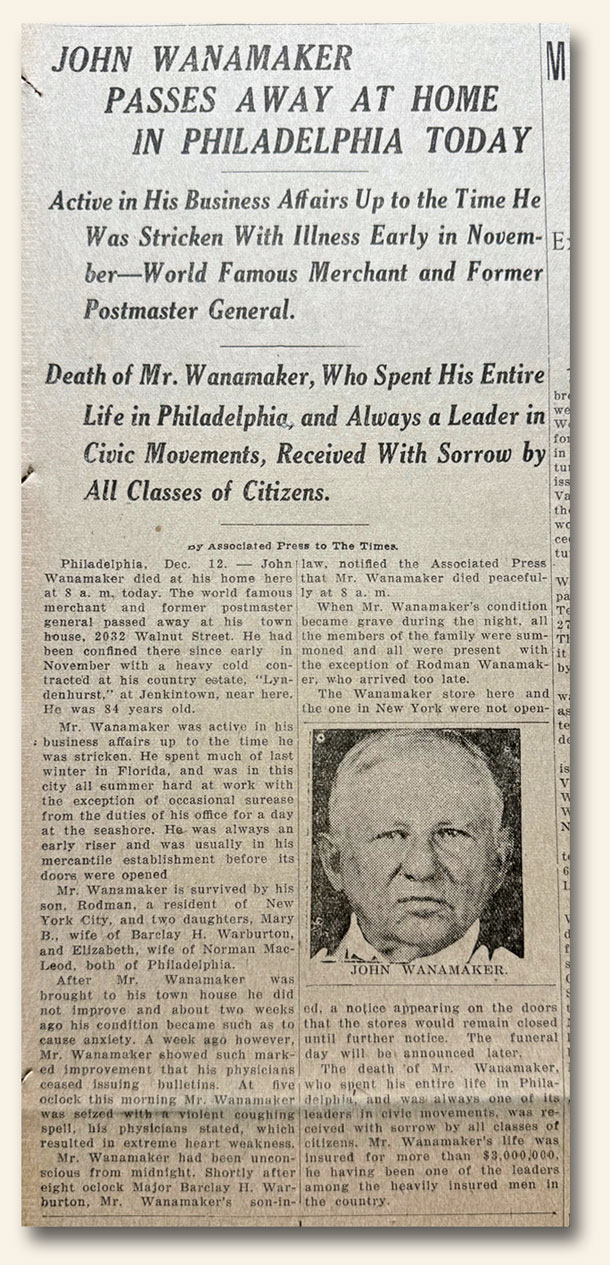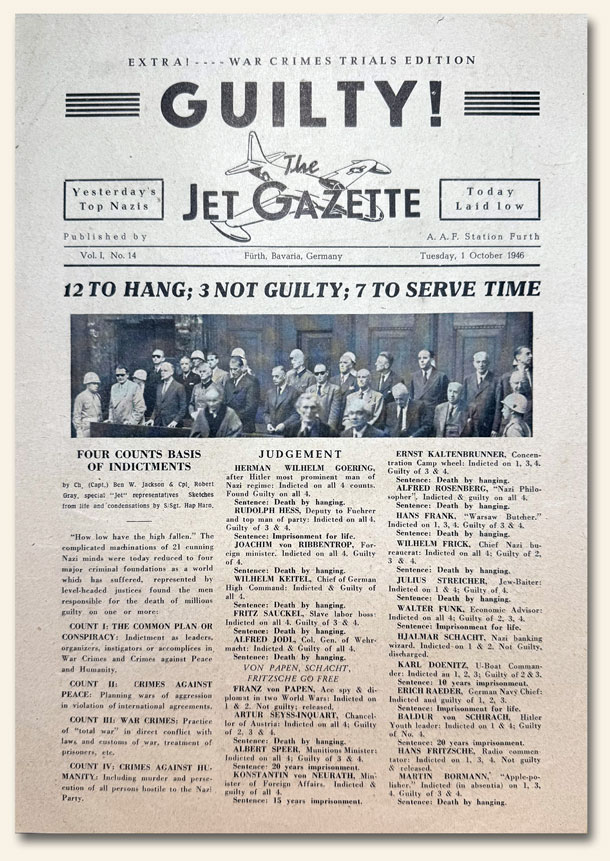From Passion to Legacy: 50 Years Strong… and Counting…
November 28, 2025 by GuyHeilenman · 10 Comments
The following, penned by the founder of Timothy Hughes Rare & Early Newspapers, appeared on the front page of our most recent catalog (#361):

It was 50 years ago this month that the Rare & Early Newspapers business began.
Having been a collector of many things in my earliest of years, primarily coins, venturing into this fascinating world of old newspapers was a logical step. I never really saw a truly old newspaper until I stumbled across an 1826 Philadelphia newspaper at a local flea market, I was convinced I had discovered an unexploited hobby. So my new adventure began.
Although I started collecting somewhat earlier, I sold my first newspaper on December 1, 1975. I used a manual typewriter to list various newspapers on a legal-size sheet of paper, then making photocopies at a local college to print multiple sheets. When an issue or two sold, I typed up replacements and taped the listings over those that sold, then made more photocopies.
How to advertise in the pre-internet era? I would place small, classified ads in various history & collector-themed magazines. As for research, I kept a set of encyclopedias next to my desk.
Eventually, the single sheets of offerings turned into small catalogs. The first formal catalog was issued in the spring of 1978 and wasn’t even numbered, as I wasn’t sure there would be another.
This catalog you have in your hands is number 361. My ad mentioned “…send 25¢…” for the catalog, which more than covered the cost of postage. Imagine that!
It was always my goal to continue to offer more issues, earlier issues, and more historic offerings with each passing month. I’ve been pleased with our progress, and for those who have been with us for many years, hopefully you’ve noticed the dramatic growth in the range of our inventory. It was my hope that collectors would look forward to each catalog, anxious to discover new “goodies” we’ve not offered before.
I became semi-retired some 23 years ago with Guy Heilenman taking over, but I remain actively involved, primarily with buying inventory. My wife and I moved West to be close to family, but I get back to Williamsport for “hands-on” work about six weeks a year.
There will be no end to this business. We remain the only full-time dealers in early newspapers in the world. At some point another generation will take over, and our inventory and offerings will, hopefully, continue to expand. I hope to remain involved for as long as God allows.
Thank you all for 50 years of fun!
Tim Hughes
Properly Directed Thankfulness – George Washington and the Foundations of a New Nation…
November 25, 2025 by GuyHeilenman · Leave a Comment
On October 3, 1789, just months into his presidency, George Washington issued the very first official presidential proclamation. Fittingly, his choice of subject set the tone for a new nation: a call for a national day of thanksgiving and prayer. In it, Washington urged the people of the United States to acknowledge “with grateful hearts the many signal favors of Almighty God, especially by affording them an opportunity peaceably to establish a form of government for their safety and happiness.” This was more than a holiday declaration—it was a reminder that gratitude, humility, and faith would form part of the nation’s foundation.
Below is the complete text of Washington’s Thanksgiving Proclamation as it appeared on the front page of the Gazette of the United States on October 7, 1789:

From the Vault: The top ten: “20th century”…
November 21, 2025 by TimHughes · 9 Comments
From this period in newspaper publishing history, displayability has much to do with the desirability of a newspaper, perhaps more so than historical significance. Since I come to this task of listing the “top ten” from the perspective of a rare newspaper dealer and knowing the requests we receive for certain events, the following list may not be the same as my most “historic” but they are my thoughts for the most “desirable” based on customer demand. Certainly FDR’s New Deal is more historically significant than the death of Bonnie & Clyde, but not more desirable from a collector standpoint. I’d be curious to hear of your thoughts.
 Here they are, beginning with number ten:
Here they are, beginning with number ten:
10) St. Valentine’s Day Massacre, Feb. 14, 1929 An issue with a dramatic banner headline, & ideally dated the 14th. Morning papers would be dated the 15th.
9) Death of Bonnie & Clyde, May 23, 1934 The gangster era remains much in demand, & perhaps due to the movie this event beats out Dillinger, Capone & the others from the era. A dramatic headline drives desirability–ideally with a photo–even if not in a Louisiana newspaper.
8.) Charles Lindbergh flies the Atlantic, May 22, 1927 The New York Times had a nice headline account with a map of the route, and the prestige of the newspaper always keeps it in high demand.
 7) Call-Chronicle-Examiner, San Francisco, April 19, 1906 I note a specific title & date for this event, as these 3 newspapers combined to produce one 4 page newspaper filled with banner heads & the latest news. No advertisements.
7) Call-Chronicle-Examiner, San Francisco, April 19, 1906 I note a specific title & date for this event, as these 3 newspapers combined to produce one 4 page newspaper filled with banner heads & the latest news. No advertisements.
6) Crash of the Hindenberg, May 6, 1937 The more dramatic the headline the better, & ideally with the Pulitizer Prize winning photo of the airship in flames.
5) Wright brothers fly, Dec. 17, 1903 Here’s where the significance of the event drives desirability over dramatic appeal. Few can argue the impact of manned flight on the world. Reports were typically brief & buried on an inside page with a small headline, so a lengthy front page report would be in top demand.
4) Stock market crash, October, 1929 Demand is driven by the dramatic headline and its wording. Too many newspapers tried to put an optimistic spin on the tragedy. Collectors want “collapse, disaster, crash” & similarly tragic words in the headline (how about Variety magazine’s: “Wall Street Lays On Egg”?)
 3) Honolulu Star-Bulletin, Dec. 7, 1941 “1st Extra” The defining issue from World War II but be careful of reprints as most issues on the market are not genuine.
3) Honolulu Star-Bulletin, Dec. 7, 1941 “1st Extra” The defining issue from World War II but be careful of reprints as most issues on the market are not genuine.
2) Chicago Daily Tribune, Nov. 3, 1948 “Dewey Defeats Truman”. What more need be said?
1) Titanic sinking, April 14, 1912 Certainly low on the historically significant list, but off the charts on the desirability scale, much due to the block-busting movie. The more dramatic the headline the better, and hopefully with a nice illustration of the ship going down.
My “honorable mention” list might include baseball’s “Black Sox” scandal of 1919, sinking of the Lusitania, end of World War II, D-Day, JFK’s election, the New Deal, a great Babe Ruth issue, etc. Maybe they would rank higher on your list. Feel free to share your top choices.
Great Headlines Speak for Themselves… The First Moon Walk…
November 17, 2025 by GuyHeilenman · Leave a Comment
The best headlines need no commentary. Such is the case with the WAPAKONETA DAILY NEWS, Ohio, July 21, 1969, which reported the first moon walk. Whereas most newspapers declared some variation of: “Man Walks on the Moon”, this one was a little more specific – perhaps because it was his hometown newspaper:
“NEIL STEPS ON THE MOON”
November Newsletter (2025) – Timothy Hughes Rare & Early Newspapers…
November 14, 2025 by GuyHeilenman · Leave a Comment
|
|
Who’s Who in Newspapers – John Wanamaker edition
November 10, 2025 by GuyHeilenman · 1 Comment
Typically, our “Who’s Who in Newspapers” series highlights individuals who were unfamiliar to me before I delved into the world of Rare & Early Newspapers. Today’s post is a departure from that norm. While reviewing the December 12, 1922, issue of The Bethlehem Times, I came across a front-page report of John Wanamaker’s passing. The article stirred a flood of childhood memories tied to this remarkable man whose legacy left a lasting impression on me. Eager to share his story, I hope the following introduction sheds light on his extraordinary contributions.
John Wanamaker: The Merchant Who Made Shopping an Experience
 From personal memories to retail innovation, Wanamaker’s left a legacy that reshaped both commerce and tradition. Every December starting in the mid-1950s, my parents bundled up my siblings and me for a trip into Philadelphia to see the Christmas light and music show at Wanamaker’s (currently being converted into a mixed-use facility). To us, it was pure magic — thousands of twinkling lights, the sound of the great pipe organ, and crowds of families gathered in awe. With my grandmother working in the store during those years, Wanamaker’s always felt like more than a department store — it felt like part of our family’s story.
From personal memories to retail innovation, Wanamaker’s left a legacy that reshaped both commerce and tradition. Every December starting in the mid-1950s, my parents bundled up my siblings and me for a trip into Philadelphia to see the Christmas light and music show at Wanamaker’s (currently being converted into a mixed-use facility). To us, it was pure magic — thousands of twinkling lights, the sound of the great pipe organ, and crowds of families gathered in awe. With my grandmother working in the store during those years, Wanamaker’s always felt like more than a department store — it felt like part of our family’s story.
That sense of wonder was no accident. John Wanamaker (1838–1922), the man behind the store, believed shopping could be more than a transaction — it could be an experience. When he opened his Philadelphia department store in 1876, it quickly became a model for modern retail. Wanamaker pioneered the one-price system (no haggling), introduced the money-back guarantee, and used newspaper advertising on a scale few had seen before.
He also reshaped how Americans paid for what they bought. Realizing that many working families couldn’t afford to pay cash for larger purchases, Wanamaker offered installment plans and charge accounts. This bold move laid the foundation for consumer credit, opening the door for more households to access quality goods.
Beyond retail, Wanamaker served as U.S. Postmaster General under President Benjamin Harrison, introducing commemorative stamps and expanding rural mail delivery. Yet it was his Philadelphia store — both marketplace and civic landmark — that became his greatest legacy.
Even today, the memory of standing with my siblings beneath the glow of the light show while the Wanamaker organ thundered through the Grand Court remains a vivid reminder of how one man’s vision reshaped not just shopping, but tradition itself.
Wanamaker’s Firsts – Innovations that reshaped retail
- One-Price System – Ended the practice of haggling; everyone paid the same fair price.
- Money-Back Guarantee – Built customer trust and loyalty.
- Large-Scale Advertising – One of the first to use newspapers to reach wide audiences.
- Department Store Experience – Turned shopping into a cultural outing with art, music, and public events.
- Consumer Credit – Introduced installment plans and charge accounts, paving the way for modern credit.

Lead-up to a Nation… as reported in the newspapers of the day (October, 1775)…
November 6, 2025 by GuyHeilenman · Leave a Comment

England Misses the Temper of the Times (Lead-up to a Nation – E9)
George Washington – Religious Freedom (Lead-up to a Nation – E10)
Ethan Allen and his Green Mountain Boys (Lead-up to a Nation – E11)
The Liberty Tree (Lead-up to a Nation – E12)
George Washington – Integrity, Leadership & Humility (Lead-up to a Nation – E13)
We hope you are enjoying this year-long trek to the 250th anniversary of The United States through the eyes of those who were fully engaged, first hand. As mentioned previously, all accounts are rooted in what they read in the newspapers of the day.
“History is never more fascinating than when read from the day it was first reported.” (Timothy Hughes, 1975)
The reason I collected it: the Nuremberg trials…
November 3, 2025 by TimHughes · Leave a Comment
I have likely stated several times that part of the quest in seeking the best report of a notable event is to find it in a newspaper as close to where it happened as possible. For the death of JFK, a Dallas newspaper is best. On the bombing of Pearl Harbor, a Honolulu newspaper is great. On the Boston Massacre in 1770, a Boston paper would be wonderful.
Some events can be extremely difficult, so you do the best you can. How about when man walked on the moon? Outside of a lunar publication that did not exist, a newspaper from Neil Armstrong’s hometown is pretty good. Or perhaps one from close to Cape Canaveral.
One of the more notable events at the conclusion of World War II was the Nuremberg Trials. There were 22 defendants held for war crimes; 12 would hang, 7 served time, and 3 found not guilty.
But finding a German newspaper with this report had eluded us. And as is the case with events in foreign language countries, a report close to the event would be diminished a bit if the text is in a language other than English. Not many desire a newspaper they cannot read.
But as luck would have it, a Nuremberg suburb–Furth–had a former Nazi air base, captured by American forces in early April, 1945 & converted to a U.S. air base. And better yet, it produced a small, obviously low-circulation newspaper called “The Jet Gazette”. The October 1, 1946 issue was devoted to the results of the trials. And being an American air base, it’s in English. It was a great find that I suspected never existed!





